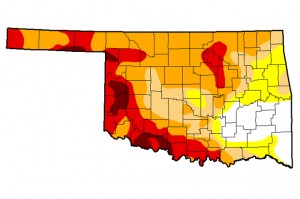Dwindling Drought Doesn’t Mean a Slowdown in Water Conservation Efforts
-
Logan Layden

U.S. Drought Monitor
The July 29 update of the U.S. Drought Monitor, which doesn't reflect the full impact of this week's rainfall.
Despite more than 80 percent of the state still being under some level of drought, recent wet weather and below average temperatures continue to reduce the severity and size of drought in Oklahoma.
As The Oklahoman‘s Graham Lee Brewer Reports, this week’s rainfall “bookended one of the wettest July’s on record for the state, with some areas receiving more than seven inches of rain.”
Including data reported just before 6 p.m. Wednesday, the statewide Oklahoma Mesonet rainfall average of rate past 30 days was 3.89 inches — 1.11 inches above normal.
That number equates to the 22nd-wettest such period dating to 1921, state climatologist Gary McManus said.
And the largest amount of rainfall came in some of the places that needed it the most. Altus had a good month in general, and this week’s rains particularly helped conditions in northwest Oklahoma.
Of the Oklahoma Mesonet weather network’s 120 stations, through Wednesday evening, Oklahoma county had the top three sites in terms of rainfall received this month, each with more than 7.25 inches.
The next highest total in the state was 7.20 inches at Altus. The Southwestern Oklahoma community continues to battle drought and has done so more on than off since October 2010.
But all the precipitation hasn’t caused long-suffering cities and towns to back away from conservation, quite the opposite. As KOCO’s Danielle Dozier reports, Altus recently partnered with Coca-Cola to give away 100 rain barrels to its residents, while metro communities are offering discounts:
Oklahoma City, Midwest City and Yukon have partnered with the Central Oklahoma Storm Water Alliance in offering discounted rain barrels ordered by clicking a link on the cities’ websites.
The U.S. Environmental Protection Agency says nearly 40 percent of household water use during the peak summer months goes toward watering lawns and gardens, and that rain barrels can save more than 1,000 gallons of water during that time.
